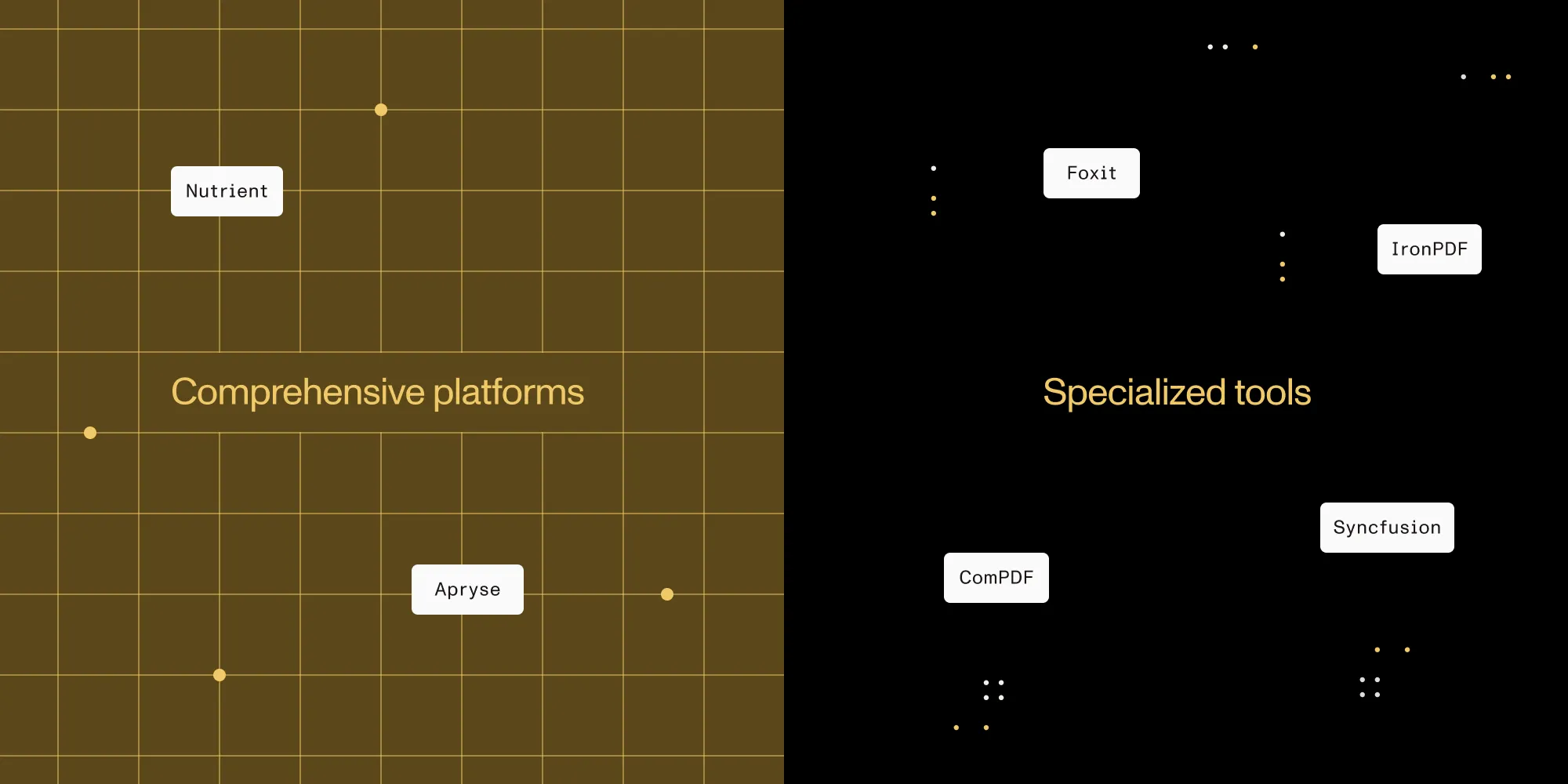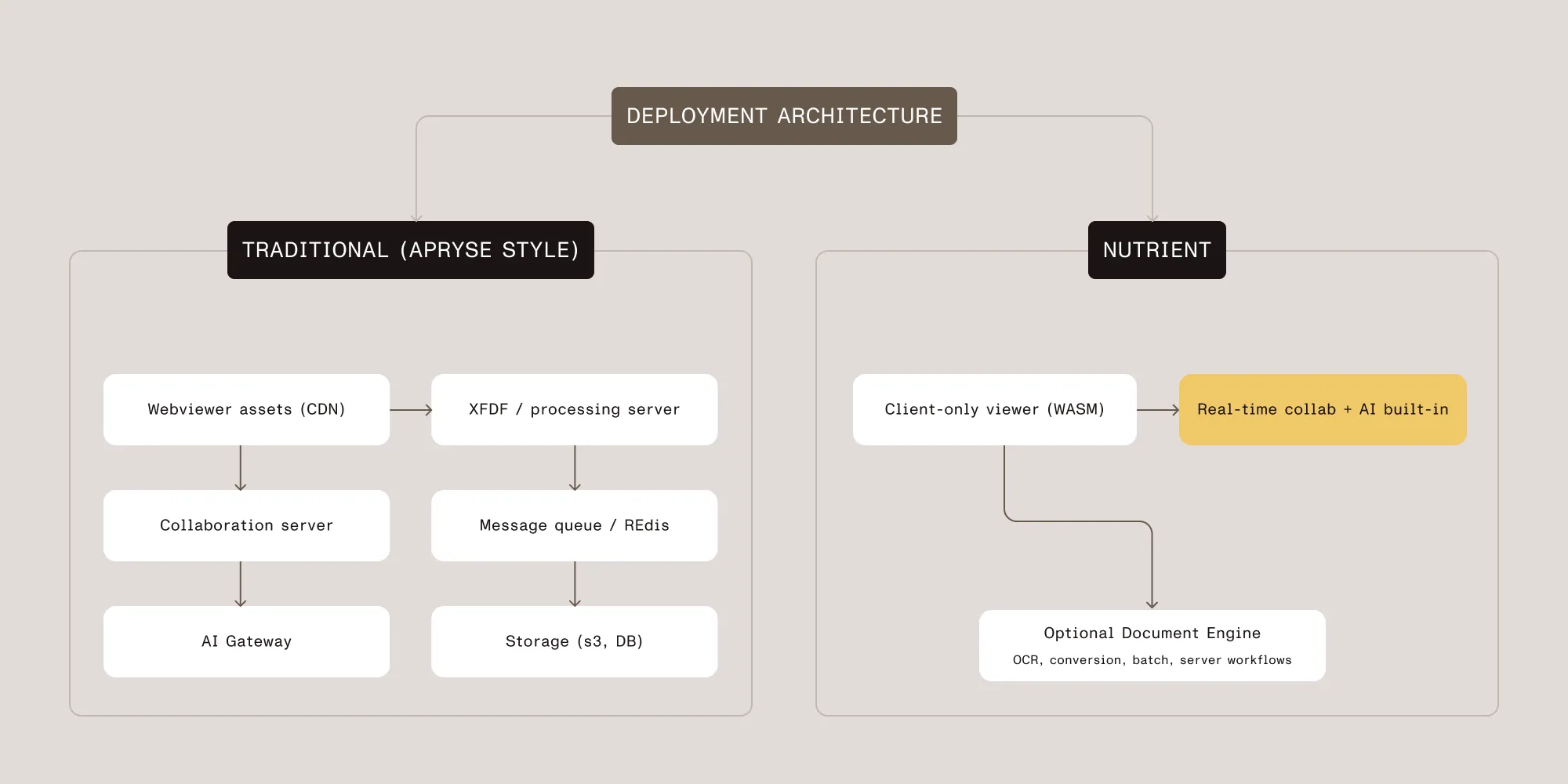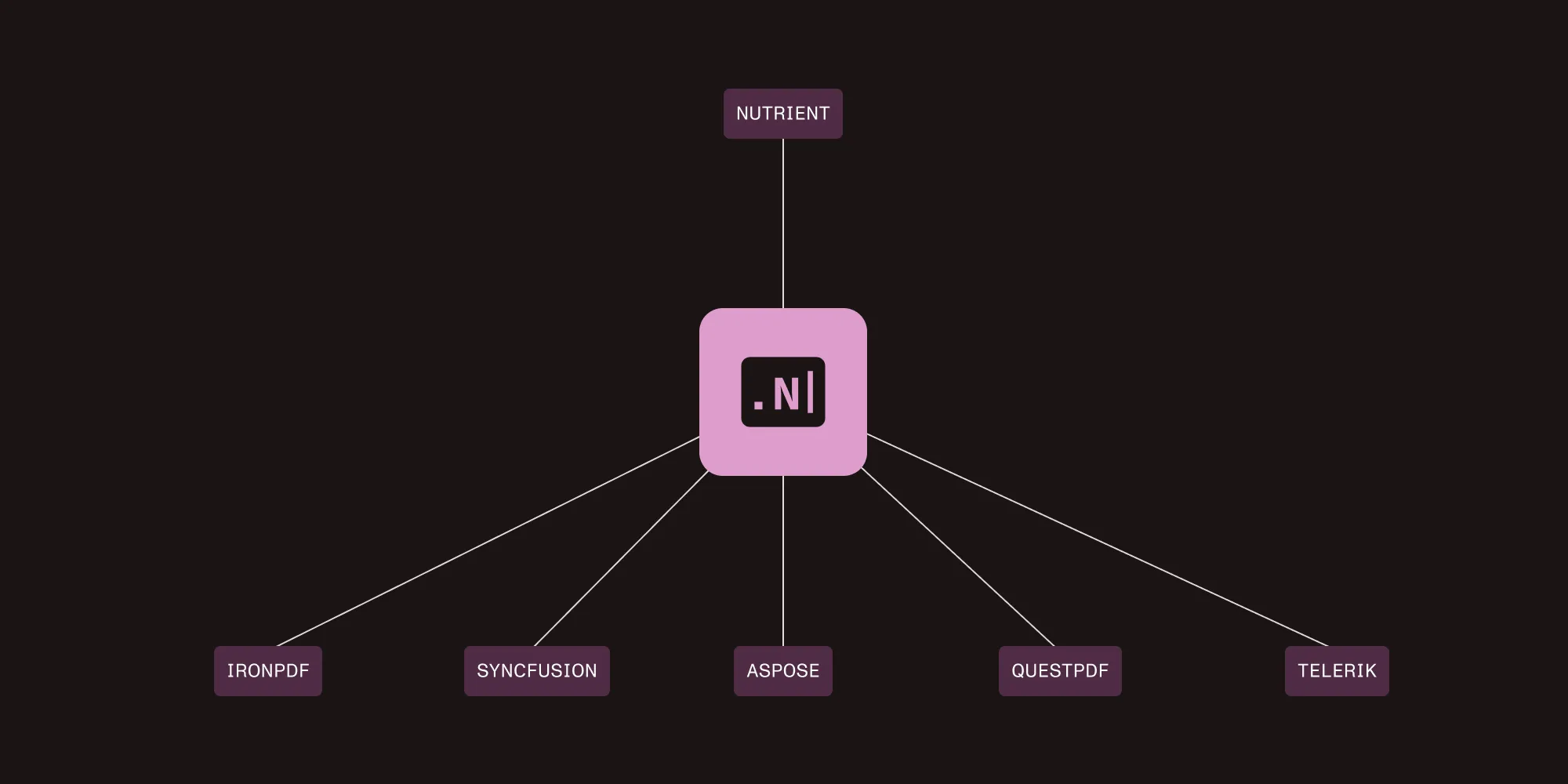Enterprise PDF SDKs: Developer-first platforms vs. specialized tools
Table of contents

Build faster with fewer moving parts.
- Nutrient SDK (developer-first) — High-fidelity viewing and robust processing with turnkey real-time collaboration and built-in AI. Ship on web, mobile, and server with a single architecture and modern JSON/TypeScript APIs. Deploy client-only, as a single self-hosted container (Document Engine), a managed service, or via cloud APIs (DWS Viewer API, DWS Processor API).
- Apryse — Powerful APIs and viewers; collaboration is DIY (sample-based backend), with multi-service operational complexity and XML/XFDF-centric workflows.
Specialized tools (Foxit, Syncfusion, IronPDF, ComPDFKit) serve single-purpose needs and aren’t designed as end‑to‑end developer platforms.
The enterprise PDF SDK market
Only a small set of developer platforms deliver the full document lifecycle. Everything else is specialized tools for narrow use cases.
Comprehensive platforms: What matters to developers
This comparison reflects our evaluation criteria as of November 2025 and focuses on developer experience, speed to ship, and operational simplicity.
Comprehensive platforms combine a high-fidelity viewer, server-side processing, and real-time collaboration across web, mobile, and server. Specialized tools handle one task (HTML to PDF, basic viewing) and require you to build everything else.
Developer-focused criteria for a “comprehensive platform”:
- Full-stack capabilities — Client-side viewing/user interface (UI) and server-side processing (conversion, OCR, redaction)
- Cross-platform parity — Web, iOS, Android, desktop/server
- Real-time collaboration — Presence, conflict resolution, syncing
- Enterprise fidelity — Forms (AcroForms), signatures, layers, embedded fonts
- Unified architecture and developer experience — Consistent APIs, modern JSON/TypeScript, single‑container or managed deployment options
Specialized tools (Foxit, Syncfusion, IronPDF, ComPDFKit) serve narrow use cases like HTML-to-PDF conversion, basic viewing, or component suites. They lack unified viewing, processing, and collaboration and expect you to build enterprise features yourself.
Tier 1: Comprehensive enterprise platforms
Among comprehensive platforms, only two vendors stand out for delivering the full document lifecycle.
1. Nutrient SDK — Developer-first platform with built-in collaboration and AI
Nutrient SDK (formerly PSPDFKit) delivers viewing, processing, collaboration, and AI in one stack — with a modern, TypeScript‑friendly API surface and a unified deployment model that minimizes moving parts. Run it fully client‑side and add Document Engine for server‑side rendering/OCR/conversion and turnkey real‑time collaboration, or consume cloud endpoints via Document Web Services (DWS) for viewing and processing.
Interactive demo
Platform architecture
Server-side processing built for developer workflows:
- Document Engine — Single-container processing (OCR, AI, conversion) that powers server-side rendering and Instant collaboration with Web SDK.
- .NET SDK and Java SDK — Native server-side libraries for PDF processing, conversion, OCR, forms, signatures, PDF/A conversion and validation, PDF/UA auto-tagging, and document manipulation.
Developer integrations:
- Document Authoring SDK — DOCX creation and editing in browsers.
- SharePoint and Salesforce — Prebuilt connectors for existing workflows.
- Cloud APIs — Simple REST APIs for viewing (DWS Viewer API) and processing (DWS Processor API) to offload heavy work without running infrastructure.
- Flexible integration — On-premises SDKs or cloud-based API endpoints.
Built-in AI and automation (no third-party glue required):
- AI Assistant — In-viewer summarization, intelligent redaction, translation, comparison, and semantic search.
- AI Document Processing — LLM-based document classification and automated field extraction with template creation for complex PDFs.
Enterprise capabilities developers rely on
Document lifecycle management:
- Digital signatures — Certificate-based digital signatures, electronic signing workflows, compliance-ready signing experiences
- Forms — Interactive form builder, field validation, form filling workflows, AcroForms support
- Viewing and collaboration — 17 markup tools, real-time multiuser editing, presence indicators, comment threads
- Document editing — Merge, split, rotate, crop, watermark, redaction, page-level operations
- Generation and advanced processing — PDF generation, OCR, conversion (PDF/Office/images), accessibility compliance (PDF/UA, WCAG)
Security and compliance framework:
- Standards compliance — SOC 2 Type 2, WCAG 2.1 AA accessibility, GDPR, HIPAA-ready deployments
- Enterprise security — Role-based access control, audit logging, encryption at rest and in transit
- Data sovereignty — On-premises, private cloud, and hybrid deployment options
Deployment options that meet you where you build
Choose the level of control without changing your code surface:
- Client-only — Runs fully in-browser via WebAssembly. No built-in real-time collaboration; suitable for solo use or non-concurrent workflows.
- Hybrid (Web SDK + Document Engine) — Offloads rendering/processing (e.g. OCR, conversion) to the server while keeping a responsive UI. Enables real-time collaboration via Instant, including syncing, conflict resolution, permissions, and incremental diffs.
- Cloud-native (as-a-service):
- Managed Document Engine — Nutrient operates your dedicated Document Engine deployment. It supports the same Instant real-time collaboration capabilities as self-hosted, without you running the infrastructure.
- DWS Viewer API — Nutrient-hosted cloud viewing service with server-side rendering. No backend setup required; supports collaboration features with cloud-backed deployments.
- DWS Processing API — Cloud-based document processing for generation, conversion, OCR, and manipulation via REST APIs without infrastructure management.
Best for:
- Teams that need built-in collaboration and AI
- Organizations using single-container deployment
- Projects using JSON/TypeScript APIs and React/Vue/Angular
- Companies avoiding custom implementation
- Cloud-native or managed deployments
Web SDK implementation
Prerequisites:
- Node.js 18+ with npm 9+ or yarn 1.22+
- Web server capable of serving static assets (webpack dev server, Vite, etc.)
Installation:
npm install @nutrient-sdk/viewer# Copy static assets.cp -R ./node_modules/@nutrient-sdk/viewer/dist/ ./assets/<div id="nutrient" style="height:100vh"></div>
<script type="module"> import "./assets/nutrient-viewer.js"; const baseUrl = `${window.location.protocol}//${window.location.host}/assets/`; // `baseUrl` must point to the parent directory that contains Nutrient assets // (e.g. the folder that includes `nutrient-viewer-lib`). NutrientViewer.load({ container: "#nutrient", document: "output.pdf", // Ensure this path exists. baseUrl, }) .then((instance) => { console.log("Loaded", instance); }) .catch((e) => console.error("Init failed:", e));</script>Check out the full Web SDK getting started guide for detailed setup instructions, including React, Vue, and Angular integration.
2. Apryse (PDFTron) — Powerful APIs; legacy libraries; collaboration is DIY
Apryse provides cross-platform PDF processing libraries and viewers (annotations, forms, signatures, conversion). For collaboration, developers typically deploy a custom WebSocket + storage backend using sample projects. This suits teams that prefer a build‑your‑own approach and have existing XFDF/XML‑centric workflows.
Capabilities:
- Document viewing — Proprietary rendering engine with support for complex PDFs, forms, and most annotation types
- Collaboration — Sample-based implementations with WebSocket patterns; requires deployment of custom server infrastructure
- Forms and signatures — Full AcroForm support, digital signatures, and form builder capabilities
- AI integration — Sample code and guidance for connecting external AI API vendors; no built-in AI assistant
- Processing — Robust server-side APIs for conversion, third-party OCR, redaction, and optimization
Deployment model:
Apryse deployments typically involve multiple components:
- Client assets — WebViewer static files served from your infrastructure or CDN
- Collaboration server (if needed) — Heavy custom implementation needed based on Apryse samples using WebSockets, database, and shared storage
- Server SDK (if needed) — Self-hosted processing libraries for third-party OCR engine, conversion, and backend operations
- License server — Concurrent user tracking and license validation
Architecture considerations:
- Multi-service complexity — Collaboration requires deploying, operating, and maintaining sample-based third-party backend services
- XML/XFDF workflows — APIs and configuration lean on legacy XML/XFDF formats vs. modern JSON-first approaches
- Operational burden — Teams maintain WebSocket infrastructure, databases, storage, and scaling logic
When it fits:
- Teams with dedicated infrastructure teams for multi-service deployments
- Organizations already standardized on legacy XML/XFDF workflows
- Projects that prefer building, maintaining, and operating their own collaboration backends with limited help from samples

Tier 2: Specialized tools (not comprehensive platforms)
The following tools focus on single, specialized tasks such as HTML-to-PDF conversion, basic viewing, or component libraries.
1. Foxit PDF SDK — Traditional enterprise with add-on architecture
Foxit PDF SDK provides cross-platform PDF viewing and editing capabilities. Foxit is primarily known as a B2C Adobe Acrobat alternative (desktop reader software), with SDK/developer tools as a secondary focus.
Strengths:
- Cross-platform SDKs — Native libraries for web, iOS, Android, Windows, Mac, Linux
- Core PDF features — Viewing, annotation, forms, signatures, and basic editing
- Brand recognition — Known for desktop PDF reader software
Limitations compared to comprehensive platforms:
- Add-on architecture — Collaboration requires deploying separate Foxit Collaboration Server
- Multi-service complexity — Requires hosting viewer assets, collaboration server, and license server separately
- B2C focus — Primary focus on desktop reader products, not developer/SDK ecosystem
- Developer experience — SDK tools and documentation less mature than Nutrient/Apryse
- Enterprise support concerns — Support experience may not match dedicated SDK-first vendors
- Limited modern patterns — Traditional API design vs. cloud-native architecture
Best fit scenarios:
- Organizations already standardized on Foxit desktop readers seeking SDK integration
- Traditional enterprise IT shops comfortable managing multi-service deployments
- Desktop-first applications where web/mobile collaboration is not a priority
2. Syncfusion — Wide component library for multiple frameworks
Syncfusion offers a broad suite of 1,600+ components, including PDF generation, viewing, DOCX editing, and document tools across .NET and JavaScript frameworks. The platform provides friendly initial pricing with quality just above open source solutions.
Strengths:
- Wide component variety — Extensive suite covering UI, data grids, charts, and document tools (PDF, Word, Excel)
- Budget-friendly initial licensing — Significantly lower cost initially but looks to scale aggressively on usage once implemented.
- Multi-framework support — .NET (ASP.NET, Blazor, MAUI, WPF), JavaScript viewers, and DOCX editor
Limitations compared to comprehensive platforms:
- Breadth over depth — Wide component library, but limited depth in any single area; PDF capabilities and robustness across a wide PDF corpus are basic compared to dedicated platforms
- Quality tradeoffs — Lower initial pricing reflects limited quality due to struggles with complex PDFs and business-level requirements
- No built-in collaboration — No real-time multiuser capabilities for PDF workflows
- Limited document fidelity — Cannot match enterprise-grade rendering, conversion, and accuracy that Nutrient/Apryse provide across a robust set of diverse and complex PDFs
- Generation-focused — PDF and DOCX viewers exist but not designed for comprehensive interactive workflows
- No AI features — Requires external service integration
- Support concerns — Spread across 1,600+ components; deep expertise in any single component may be limited
Best fit scenarios:
- Cost-conscious projects where budget is the primary driver
- Teams needing a variety of basic components (data grids, charts, basic PDF/Word tools) from one vendor
- Organizations already using Syncfusion suite seeking to add basic document capabilities
- Simple use cases where open source isn’t quite enough but enterprise quality isn’t required
3. IronPDF SDK — .NET HTML-to-PDF conversion
IronPDF is a .NET-only library specialized in HTML-to-PDF conversion and basic PDF manipulation. It’s a limited backend library that checks the box on functionality but isn’t robust enough in quality, accuracy, and fidelity for most business production use cases.
Strengths:
- HTML-to-PDF focus — Specialized for converting web content to PDFs
- NuGet simplicity — Easy installation for .NET developers
- Basic manipulation — Merge, split, watermark, sign operations
Limitations compared to comprehensive platforms:
- .NET only — No cross-platform support (no mobile, no other languages)
- Backend-only — No client-side viewer; requires separate UI implementation
- Check the box — Lacks accuracy, validation, and handling across a comprehensive PDF corpus.
- No AI capabilities — No document intelligence features
- Limited scope — HTML conversion and basic editing only, not comprehensive document handling
Best fit scenarios:
- .NET projects needing simple HTML-to-PDF conversion (reports, receipts, invoices)
- Backend-only workflows without client-side viewing requirements
- Teams looking to check the box and not needing business-grade fidelity or robustness.
4. ComPDFKit — Affordable cross-platform toolkit (with elevated vendor risk)
ComPDFKit provides PDF viewing and editing across multiple platforms at a low cost. The toolkit offers functionality just above open source solutions.
Strengths:
- Multiplatform presence — Web, iOS, Android, Windows, Mac, Linux SDKs
- Basic features — Viewing, annotation, forms, signing, OCR
- Framework support — React Native, Flutter integrations
- Low cost — Affordable pricing for basic use cases
Limitations compared to comprehensive platforms:
- Quality concerns — Low-cost, lower-quality solution; document fidelity may not meet enterprise standards
- Enterprise support questions — Unclear if support infrastructure can handle enterprise-scale deployments and SLAs
- Limited enterprise features — Basic commenting and annotation, not enterprise-grade workflow systems
- Document fidelity risks — May struggle with complex PDFs that Nutrient/Apryse handle seamlessly
- Lack of ecosystem maturity — Less mature than established platforms; unclear long-term viability or third-party verifiability of vendor claims
- Due diligence imperative — Elevated vendor risk requires thorough evaluation, export/regional support, data sovereignty, SLAs, legal jurisdiction, and compliance checks
Best fit scenarios:
- Price-sensitive projects where cost takes priority over anything else
- Simple cross-platform viewing applications with basic annotation needs
- Prototypes or MVPs where enterprise-grade fidelity isn’t required
- Teams willing to accept higher vendor risk and long-term reliability risks
Feature comparison matrix
Tier 1: Comprehensive enterprise platforms
| Feature | Nutrient SDK | Apryse (PDFTron) |
|---|---|---|
| Viewing + processing | ✅ Unified platform | ✅ Unified platform |
| Cross-platform (web/mobile) | ✅ Full parity | ✅ Full parity |
| Real-time collaboration | ✅ Built-in (via Document Engine/Instant) | ◑ Sample-based (custom backend required) |
| AI capabilities | ✅ Built-in AI Assistant (add-on) | ◑ Sample code for external AI integration |
| API design | ✅ JSON/REST/TypeScript-first | ◑ XML/XFDF-centric |
| Deployment complexity | ✅ Single container, managed, or cloud APIs | ◑ Multi-service (viewer + collaboration + licensing) |
| Developer velocity | ✅ Turnkey platform with minimal glue | ◑ Assemble components from samples |
| Server-side processing | ✅ OCR, conversion, redaction, optimization | ✅ OCR, conversion, redaction, optimization |
| Security/compliance | ✅ SOC 2 Type 2, RBAC, audit, encryption | ✅ Enterprise security features |
Tier 2: Specialized tools
| Feature | Foxit SDK | Syncfusion | IronPDF | ComPDFKit |
|---|---|---|---|---|
| Primary use case | Traditional enterprise | Component suite (.NET/JS) | HTML to PDF (.NET) | Basic viewing |
| Cross-platform | ✅ (Add-on architecture) | ◑ (.NET/JS, limited depth) | ❌ (.NET only) | ✅ (Basic quality) |
| Real-time collaboration | ◑ Separate add-on server | ❌ | ❌ | ❌ |
| AI capabilities | ❌ | ❌ | ❌ | ❌ |
| Viewing + processing | ◑ Requires multiple parts | ◑ (Generation-focused, limited viewing) | ❌ (Backend generation only) | ◑ Basic |
| Document fidelity | ◑ Good | ◑ Limited | ◑ Basic | ◑ Basic |
| Best for | Multiplatform apps | Cost-effective multicomponent suite | .NET HTML exports | Simple viewers |
Key takeaway: Nutrient and Apryse both cover robust viewing and processing at enterprise quality — but only Nutrient ships real‑time collaboration and document AI as turnkey capabilities with a unified, developer‑friendly technology stack. Other specialized tools may handle single functionality just above open source quality, but they come with hidden risks like requiring you to build and maintain functionality on top, vendor diligence risks, and lack of robust business tested production level quality.
Migration from Apryse — The essentials
Many enterprises consider switching from Apryse to Nutrient for modern architecture, frustration with support responsiveness after signing up, and modern functionality like collaboration and document AI features.
Migration checklist
- Data — Map XFDF/XML to JSON (annotations, forms, comments)
- Authentication/authorization — Align tokens/permissions with the new collaboration model
- Infrastructure — Consolidate multi-service backends into a single container or managed APIs
- Parity — Validate forms/signatures, redaction, conversion on representative files
- Cutover — Run in parallel, migrate in cohorts, track performance and UX
Note: Actual timelines vary by scope, data volume, integrations, and internal approval processes.
Decision framework
If you’re a developer building production quality document workflows and need viewing, processing, and collaboration across platforms with enterprise-grade fidelity, accuracy, and compliance, evaluate the operational model and quality as much as the feature list.
Choose Nutrient for developer velocity and simplicity:
- Turnkey collaboration — Built‑in real‑time collaboration via Document Engine (presence, conflict resolution, offline syncing)
- Integrated AI — In‑viewer AI Assistant: summarization, intelligent redaction, translation, comparison, semantic search
- Modern APIs — JSON‑first, TypeScript types, React/Vue/Angular examples, REST endpoints
- Unified deployment — Client‑only, single container, managed, or cloud APIs — same SDK, fewer moving parts
- Ship faster — Production‑ready collaboration without building/operating custom backends
Consider Apryse when you plan to assemble collaboration yourself:
- DIY collaboration and AI — Implement from samples and integrate third-party services (WebSocket servers, databases, storage, conflict handling)
- XML/XFDF workflows — Prefer legacy XML/XFDF‑centric configuration
- Multi‑service operations — Comfortable deploying and maintaining multiple services internally (viewer, collaboration backend, licensing)
For single, limited capabilities:
Use specialized tools only for truly narrow needs:
Foxit — Cross-platform viewing with traditional add-on architecture (requires managing separate collaboration servers)
Syncfusion — Wide component suite for basic tools (PDF/Word/Excel across .NET/JavaScript; initial cost-effective option, limited depth)
IronPDF — .NET HTML-to-PDF conversion only (backend tool, no viewer)
ComPDFKit — Basic cross-platform viewing (low-cost option, no collaboration, cost matters more than quality)
If you need more than one capability or business-grade quality (viewing and collaboration, conversion, OCR and forms, signing, etc.), you need an enterprise-quality comprehensive document platform — not specialized one-off libraries you’ll outgrow or run into issues with.
Conclusion
Start by defining your actual problem — not comparing feature lists.
If you’re building for enterprise document functionality that requires robust fidelity, complex and large PDF handling, and multi-platform support, you need a comprehensive platform. Only Nutrient and Apryse deliver this — choose based on whether you prioritize turnkey features and modern architecture (Nutrient) or build-your-own flexibility and legacy approach (Apryse).
If you need one capability at just-above open source quality — such as .NET HTML-to-PDF conversion or basic viewing — specialized tools work. If you need two or more capabilities (viewing and document processing), you need a platform.
Choosing a specialized tool and planning to “add features later” costs 6–12 months of engineering for collaboration alone. Document fidelity requires deep PDF expertise most teams lack. You’ll rebuild on a platform anyway after wasting months on the wrong foundation.
Start with the right foundation: If there’s any chance you’ll need comprehensive document capabilities, choose Nutrient or Apryse from day one.
Ready to evaluate Nutrient? Try Nutrient SDK free for 30 days or contact Sales to discuss your document platform requirements.
FAQ
Comprehensive PDF platforms require: unified viewing and processing across all platforms; enterprise document fidelity (complex PDFs with forms/signatures/layers/fonts); comprehensive APIs; real-time collaboration; and production scale. Only Nutrient and Apryse deliver this complete stack. Other tools focus on narrow use cases (HTML conversion, basic viewing, .NET generation) but lack platform-level capabilities.
No. Specialized tools (Foxit, Syncfusion, IronPDF, ComPDFKit) serve different needs entirely. They’re single-purpose tools for narrow use cases like .NET HTML-to-PDF conversion only or basic viewing only. They lack unified viewing, processing, and collaboration; enterprise document fidelity; and comprehensive APIs. If you need a document platform, your choice is Nutrient or Apryse — not specialized tools.
Both are comprehensive enterprise platforms powering Fortune 500 document workflows. Nutrient delivers turnkey collaboration/AI, modern JSON APIs, single-container deployment, and 2–4 month implementation. Apryse offers a mature ecosystem but requires implementing collaboration from sample code (custom WebSocket servers, databases) and managing multi-service architecture. Choose based on: turnkey features plus modern architecture (Nutrient) or a proven track record plus a build-your-own approach (Apryse).
This isn’t recommended. Building enterprise capabilities yourself requires: 6–12 months for real-time collaboration, deep PDF expertise for document fidelity (forms, signatures, layers), complex AI integration, and multiplied effort for cross-platform parity. If you need more than one capability (viewing plus collaboration, processing plus forms, etc.), choose a comprehensive platform (Nutrient or Apryse) from the start. Specialized tools work only for single, narrow needs.
Nutrient offers platform completeness out of the box. Nutrient ships collaboration, AI, and modern APIs as turnkey features — deploy Document Engine and everything works. Apryse provides comprehensive APIs but requires implementing collaboration from sample code (WebSocket servers, databases, storage, conflict handling). Both handle enterprise document fidelity at scale; Nutrient ships faster with modern architecture, while Apryse offers a longer proven track record with a build-your-own approach.
Choose a specialized tool only when you have a single, narrow need and don’t require comprehensive document capabilities: Syncfusion for a basic multicomponent suite (data grids, charts, basic PDF/Word tools); IronPDF for .NET HTML-to-PDF conversion only; ComPDFKit for basic viewing only. If you need viewing and processing, collaboration, forms, signatures, AI, or cross-platform support, you need a comprehensive platform (Nutrient or Apryse) — not specialized tools you’ll outgrow.







